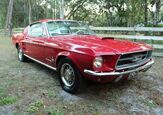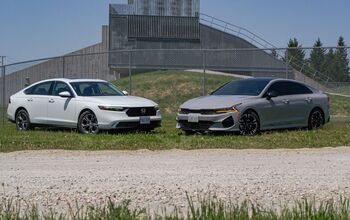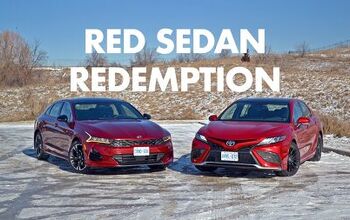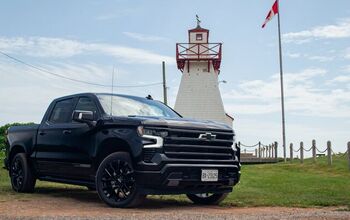Volkswagen Jetta vs Kia K4 Comparison

You want a compact car—great! But you don’t want to go with the typical Honda Civic or Toyota Corolla.
Yes, the Japanese duo accounts for the lion’s share of the segment, but for those looking to make a statement, might we suggest two other choices in the shape of the refreshed 2025 Volkswagen Jetta or all-new 2025 Kia K4? Both of these not-so-small four-doors took part in our latest compact car mega-comparison earlier this year and stood out for very different reasons. As two turbocharged options, the Jetta and K4 needed a closer look, so that’s exactly what we’ve done here.
Volkswagen Jetta vs Kia K4 Quick Take
Offering up turbo torque and oodles of space in the compact car scene, the Volkswagen Jetta and Kia K4 might seem similar on paper, but which one makes sense for you depends on where your priorities lie: comfort and efficiency, or tech and power.
What’s New for 2025:
Volkswagen gave the Jetta another facelift for this year, sticking to the bones that have served it well since it debuted for the 2018 model year. This is a facelift in the truest sense: almost entirely visual, with tweaked styling outside as well as in, along with added standard tech and the same 8.0-inch touchscreen across all trims. The familiar 1.5-liter turbocharged four-cylinder makes a useful 158 horsepower and 184 pound-feet; the Jetta doesn’t enjoy the slight pony bump the Taos does.
The K4 is all-new this year, replacing the Forte in Kia’s lineup. It’s longer and wider than before, promising more room for folks front and back. Under the skin, the K4 borrows much from the Forte as well as the Hyundai Elantra, with the choice of a 2.0-liter naturally-aspirated four-cylinder or this GT-Line tester’s turbocharged 1.6-liter motor, which throws down 190 hp and 195 lb-ft. Buyers will have the option of a K4 hatchback starting later this year.
Exterior Style:
To our eyes, this second facelift for the Jetta is the best one. Thinner headlights give the VW a more assertive glare, while the back-end sees the oh-so-common full-width taillight treatment. It’s a handsome and premium-looking thing, right down to that most modern scourge of luxury vehicles: faux exhaust trim.
The K4 applies Kia’s latest, ultra-angular design language to a car shape to… divisive effect. Seriously, no other car in the mega comparison drew so many love-it/leave-it comments, oftentimes from the same person. Some angles work better than others: the front and rear three-quarters highlight the width and the low-nose, high-tail stance nicely. Meanwhile, the profile shows how much visual weight is centered right above the rear wheel, and the interplay between the pillar, roof, and rear window makes it seem like part of the car still needs to load. The wide and low rear lighting signature looks incredibly cool at night, mind you.
2025 Volkswagen Jetta: All the Details
Powertrain and Fuel Economy:
Both of these cars feature small, turbocharged four-cylinders, with power funneled to the front-wheels via eight-speed automatic transmissions. On paper the Jetta has a 32-pony disadvantage, but its ample torque and lower curb weight (3,093 pounds / 1,403 kilograms) means that day-to-day speediness is largely even. How that power is doled out is unfortunately not, however.
The Jetta has some serious lag between pedal inputs and response. A full second or more can pass before the engine wakes up, and when it does, it sends all 184 pound-feet to the tires. “When at full power, it’s a torque-rich mini-monster that thrusts the car forward,” notes Schlee. The result is a car that is hard to drive smoothly in stop-and-go traffic. It’s almost as if VW is getting us back for calling the old DCT jerky.
By comparison, the Kia’s eight-speed auto—also a replacement for a dual-clutch in the Forte—is… fine. We’ve also dinged this ‘box before for tardy responses, but the Korean brand has seemingly done its homework. Shifts are quick and right when we want them, making the K4 a pleasantly powerful little ally in the city. There’s even a nicely rorty exhaust note.
The counterpoint to this goodness is some serious drinking. Officially the Kia scores 26 mpg city and 36 mpg highway for just 29 mpg combined. (Canadian figures: 9.2, 6.6, and 8.0 L/100 km, respectively). Our test loop saw a useful 31 mpg (7.6 L/100 km). By comparison, the Jetta sips to the tune of 29, 40, and 33 mpg (8.4, 6.1, 7.4 L/100 km), respectively. And we saw even better in the loop: 37 mpg (6.4 L/100 km).
Handling and Drivability:
The Jetta has a very typical German feel behind the wheel: calm, composed, yet happy to be gently flung along the scenic route. Good damping keeps it athletic in the corners, but never too stiff. Highway driving is another strong point in the Jetta: it feels rock solid in stability terms, needs little prodding to stay up to speed, and swallows up bumps. The left pedal is similarly German: good initial bite for confidence and progressive feel throughout.
We expected more of the K4. “The Kia K4 is no slouch in the bends either, and being the GT-Line, is more set up for performance, but overall, it doesn’t quite have the engaging response the Jetta does.” Sure the GT-Line is more overtly sporty, but not always in a good way. Its suspension is stiff but can’t deal with mid-corner bumps well, transmitting noise and harshness through into the cabin. There’s plenty of mechanical grip to yank the big sedan through corners, but the Kia never actually feels like it wants to be threading the needle. The light steering doesn’t provide much feedback, though it will happily succumb to torque steer if you get greedy with the throttle. Kia’s brakes, meanwhile, are powerful and easy to modulate.
Ride Quality and Comfort:
Ride quality is as expected given the experiences above: the Jetta is a smooth performer with a Germanic firm-yet-controlled ride. There’s very little road or wind noise on the highway either, adding to the premium feel. By comparison, the Kia is a little rougher around the edges, jiggling its way over speedbumps and potholes.
Front-seat comfort is not exactly class-leading in either vehicle, for different reasons. The Jetta’s seats feel like stools, with a high-mounted cushion that manages to be both flat and stiff. The K4’s low-mounted seat is immeasurably better in terms of both comfort and support, but a lack of headroom—a modern Kia hallmark—makes it a tighter fit for taller folks.
It’s a similar story in the back row: the K4’s measurements can’t quite match the larger Jetta’s, but the combination of comfier seats and added natural light from its quarter-window make this the better backseat. The Jetta’s seats are weirdly less flat than those in the front…
Kia likes to tout the K4’s enormous 14.6 cubic foot (413-liter) trunk, which is around a half-cube bigger than that of the Jetta. In the real world, the Jetta’s opening is larger and its space squarer, making it the more useful option.
2025 Kia K4 GT-Line: All the Details
Interior Style and Quality:
With soft brown leather and a clean, driver-focused design, the Jetta is the elevated old-school option here. It doesn’t take many risks, but that also suggests it will age well. Yes, there’s plenty of piano black, but at least it’s in spots we’re unlikely to touch much. Some of the plastics lining the lower dashboard and rear door panels are a bit brittle, but beyond that, the Jetta cabin is a pleasant space to spend time in during rush hour.
Like the exterior, the K4’s cabin is dramatic. The angular shape of the upper dashboard mirrors the outside shoulder lines, while gray plastic protuberances below double as physical controls. There are a lot of textures, giving the Kia a distinctly modern, techy feel. We like the splashes of cream color to brighten the space up, too. One clear area where the Kia excels is in storage space, with deep door pockets in both rows. Material quality is at the level of the Jetta so long as you’re looking directly ahead: the door panel plastics do feel cheap.
Technology and Safety:
Volkswagen has kept its older 8.0-inch touchscreen on duty here in the Jetta, and that’s largely a good thing, because it skips the frustrating touch controls of the newer system and is still pleasantly simple to operate. Not to miss an opportunity aggravate us, Volkswagen has switched to touch-sensitive HVAC controls below. At least they light up! VW’s digital instrument cluster is one of the best in the segment, with crisp graphics and loads of available information. Its secret weapon? The ability to put the (native) navigation right behind the wheel. Excellent.
The Kia has more screen real estate, though its native user interface isn’t necessarily better—just different. Response times are quick, and this top-shelf tester has the larger digital instrument cluster that, like the VW, provides plenty of customization for the driver. Not to be outdone in the over-complicated-climate-controls stakes, Kia employs a combination of physical controls (yay!) and a tiny portion of touchscreen dedicated to HVAC (boo!). This panel also sits between the cluster and main screen, usually blocked at least slightly by the steering wheel. Ugh.
Both cars feature useful tech like front-seat ventilation, memory seating, and solid audio systems. Robust safety assists abound, though the Kia has the advantage of the always-useful Blind-spot View Monitor and a 360-degree camera. Its full-range adaptive cruise control is also more natural in its operation.
Value, Dollars, and Sense:
Both of these cars represent some of the most affordable starting prices on the market: In America they both start under $24,000 including destination. The Jetta is the value play at $30,225; the Kia’s $31,465 isn’t bad considering all of its tech.
In Canada, the Kia has the clear advantage at the lower end of the trim walk, as a base K4 lists for $25,845 CAD, exactly $2,000 CAD more than the Volkswagen. As equipped, that gap grows to $2,100 CAD in favor of the Jetta ($34,245 CAD against $36,345 CAD).
Final Thoughts: Volkswagen Jetta vs Kia K4 Comparison
Neither of these cars are without flaws: if they were, they would’ve won that mega-comparison, after all. We appreciate Kia taking a big swing with the K4. The old Forte felt like it was just copying the class, whereas the K4, even with its issues, is at least its own thing. It’s a distinctly sporty choice in the segment—we just wish it were better sorted.
Both Mike and I would take the Jetta, accepting its unruly transmission for the premium feel of the ride and the incredible fuel economy. And, if we wanted sporty, a Jetta GLI is barely more than the Kia’s price. Volkswagen’s compact car might not be the newest entry in the class, but it’s the winner here.
Become an AutoGuide insider. Get the latest from the automotive world first by subscribing to our newsletter here.
Category | Volkswagen Jetta SEL (Highline in CA) | Kia K4 GT-Line Turbo (Limited in CA) |
|---|---|---|
Powertrain | 7 / 10 | 7 / 10 |
Efficiency | 9 / 10 | 7 / 10 |
Handling and Drivability | 7 / 10 | 7 / 10 |
Passenger Comfort | 7 / 10 | 8 / 10 |
Ride Quality | 4 / 5 | 3 / 5 |
Exterior Style | 4 / 5 | 4 / 5 |
Interior Style and Quality | 8 / 10 | 8 / 10 |
Infotainment | 8 / 10 | 8 / 10 |
Cargo Capacity and Towing | 4 / 5 | 4 / 5 |
Safety | 4 / 5 | 4 / 5 |
Value | 8 / 10 | 7 / 10 |
Emotional Appeal | 7 / 10 | 7 / 10 |
TOTAL | 77 / 100 | 74 / 100 |
Volkswagen Jetta SEL (Highline in CA) | Kia K4 GT-Line Turbo (Limited in CA) | |
Engine: | 1.5L I4 Turbo | 1.6L I4 Turbo |
Output: | 158 hp, 184 lb-ft | 190 hp, 195 lb-ft |
Drivetrain: | FWD | FWD |
Transmission: | 8AT | 8AT |
US Fuel Economy (mpg): | 29/40/33 | 26/36/29 |
CAN Fuel Economy (L/100 km): | 8.4/6.1/7.4 | 9.2/6.6/8.0 |
Starting Price (USD): | $23,720 (inc. dest.) | $23,165 (inc. dest.) |
As-Tested Price (USD): | $30,225 (inc. dest.) | $31,465 (inc. dest.) |
Starting Price (CAD): | $27,845 (inc. dest.) | $25,845 (inc. dest.) |
As-Tested Price (CAD): | $34,245 (inc. dest.) | $36,345 (inc. dest.) |

Kyle began his automotive obsession before he even started school, courtesy of a remote control Porsche and various LEGO sets. He later studied advertising and graphic design at Humber College, which led him to writing about cars (both real and digital). He is now a proud member of the Automobile Journalists Association of Canada (AJAC), where he was the Journalist of the Year runner-up for 2021.
More by Kyle Patrick











































Comments
Join the conversation